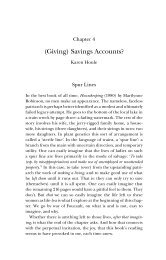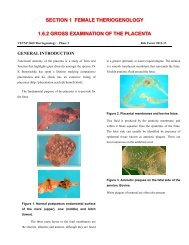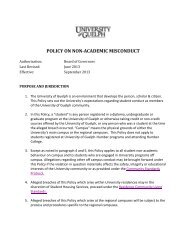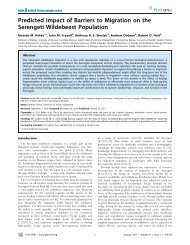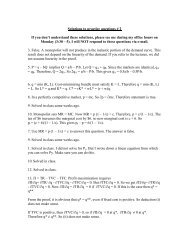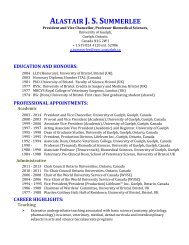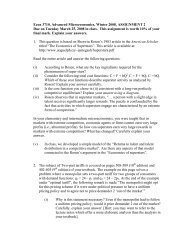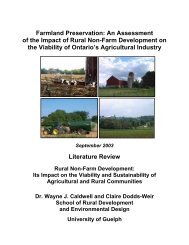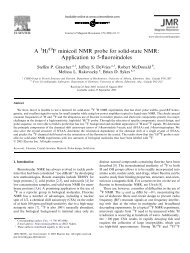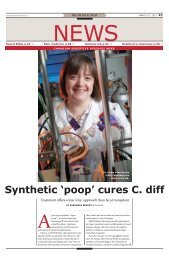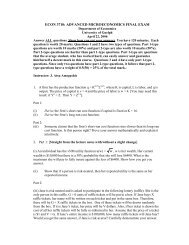The biology of Canadian weeds. 117. Taraxacum officinale G. H. ...
The biology of Canadian weeds. 117. Taraxacum officinale G. H. ...
The biology of Canadian weeds. 117. Taraxacum officinale G. H. ...
Create successful ePaper yourself
Turn your PDF publications into a flip-book with our unique Google optimized e-Paper software.
Oxlade 1989). <strong>The</strong> scape elongates to bloom, then bends<br />
down close to the ground while the seeds mature, where it<br />
can escape injury from lawnmowers or grazers (Longyear<br />
1918; Richardson 1985). When seeds are nearly mature, the<br />
scape elongates again up to 75 cm, maximizing its height for<br />
effective dispersal <strong>of</strong> the wind-blown seeds (Longyear<br />
1918; Jackson 1982; Richardson 1985). <strong>The</strong>refore, the scape<br />
grows upright (negatively orthogeotropic) when extension<br />
growth is rapid, as it is prior to flowering and during formation<br />
<strong>of</strong> the inflorescence (Oxlade and Clifford 1981).<br />
However, between these stages, when extension growth is<br />
minimal and the inflorescence is closed, the scape can grow<br />
parallel to the ground (diageotropic) for some or most <strong>of</strong> its<br />
length (Oxlade and Clifford 1981). <strong>The</strong> outer tissue layers <strong>of</strong><br />
T. <strong>of</strong>ficinale scapes are held in a state <strong>of</strong> longitudinal tension<br />
by internal stem tissues, which are held in a reciprocal state<br />
<strong>of</strong> compression (Niklas and Paolillo 1998).<br />
Fasciation has been recorded in T. <strong>of</strong>ficinale in two forms,<br />
confined to the reproductive tissues <strong>of</strong> the plant (Dekker<br />
and Dekker 1987). In plants with multiple scapes, the<br />
central scapes can be fused together to form one broad<br />
(1–2 cm) scape; or inflorescences (2–4) can be fused at their<br />
base to form a longitudinal floral structure (Dekker and<br />
Dekker 1987).<br />
(b) Perennation. <strong>Taraxacum</strong> <strong>of</strong>ficinale overwinters as seed<br />
or it retains a reduced basal rosette under snow cover (Cyr<br />
et al. 1990).<br />
(c) Physiological data. <strong>Taraxacum</strong> <strong>of</strong>ficinale leaves are rich<br />
in fibre, potassium, iron, calcium, magnesium, phosphorus,<br />
vitamins A and C, the B vitamins thiamine and rib<strong>of</strong>lavin,<br />
and protein (Schmidt 1979; Jackson 1982; Gail 1994). Gail<br />
(1994) reported that they are also nature’s richest vegetable<br />
source <strong>of</strong> β-carotene at 0.84 mg g –1 tissue compared to carrots<br />
(Daucus carota L.) at 0.61 mg g –1 tissue. <strong>The</strong>y rank<br />
above broccoli (Brassica oleracea L.) and spinach<br />
(Spinacia oleracea L.) in overall nutritional value<br />
(Haytowitz and Matthews 1984), and Minnich (1983)<br />
ranked them out <strong>of</strong> all vegetables (including grains, seeds<br />
and greens) as tied for ninth best, higher than lettuce<br />
(Lactuca sativa L.). Also, the roots <strong>of</strong> T. <strong>of</strong>ficinale are rich<br />
in iron, copper and other trace elements (Dwyer 1977). <strong>The</strong><br />
most prominent therapeutic property <strong>of</strong> T. <strong>of</strong>ficinale is the<br />
diuretic activity, which is based on the high potassium content<br />
<strong>of</strong> the plant (Hook et al. 1993). It is superior to other<br />
diuretics because it reduces the likelihood <strong>of</strong> hypokalaemia,<br />
a common side-effect <strong>of</strong> many diuretics (Houghton 1995).<br />
<strong>The</strong> major and trace element content <strong>of</strong> T. <strong>of</strong>ficinale alters<br />
with growth stage (Müller and Kirchgessner 1972). In a<br />
Finnish study, the vitamin C content was lowest, while dry<br />
matter, soluble solids and mineral content were highest in<br />
late summer (Kuusi et al. 1982). Dandelion mineral content<br />
was investigated by van der Kley (1956) to assess the suitability<br />
<strong>of</strong> this species as feed for livestock. <strong>The</strong> high<br />
amounts <strong>of</strong> protein and β-carotene, favourable mineral composition,<br />
and low nitrate content throughout the growing<br />
season in Poland provided a high value feed (Falkowski<br />
et al. 1990). In UK studies, the availability <strong>of</strong> these elements<br />
STEWART-WADE ET AL — TARAXACUM OFFICINALE G. H. WEBER EX WIGGERS 833<br />
was equivalent to that in perennial ryegrass (Lolium perenne<br />
L.), a popular forage species (Wilman and Derrick 1994).<br />
<strong>Taraxacum</strong> <strong>of</strong>ficinale also had a lower proportion <strong>of</strong> cell<br />
walls in dry matter than perennial ryegrass (Derrick et al.<br />
1993). <strong>The</strong> true dry matter digestibility was as high as that<br />
<strong>of</strong> ryegrass, but the in vivo digestibility was lower (Derrick<br />
et al. 1993).<br />
<strong>The</strong> qualitative and quantitative distribution <strong>of</strong><br />
carotenoids in T. <strong>of</strong>ficinale inflorescences did not change,<br />
regardless <strong>of</strong> the year, season or location <strong>of</strong> sampling (Tóth<br />
and Szabolcs 1970). Pollen <strong>of</strong> T. <strong>of</strong>ficinale contained<br />
carotenoids, leucoanthocyanidins, flavonols and ascorbic,<br />
chlorogenic, triterpene, palmitic, stearic, linoleic and<br />
linolenic acids (Bandyukova et al. 1983). Bandyukova et al.<br />
(1989) found the amino acid composition <strong>of</strong> pollen to be<br />
similar to that <strong>of</strong> pollen <strong>of</strong> other plants. <strong>The</strong> pollen contained<br />
a low concentration <strong>of</strong> ct-ABA (cis trans abscisic acid) and<br />
a high concentration <strong>of</strong> proline, which serves several functions<br />
including drought and cold resistance (Lipp 1991).<br />
Callus development, and leaf and root formation,<br />
occurred in tissue cultures isolated from secondary thickened<br />
roots <strong>of</strong> T. <strong>of</strong>ficinale (Bowes 1970). Tissue cultures<br />
produced the same spectrum <strong>of</strong> compounds as intact plants<br />
and, in actively growing suspension cultures, volatile<br />
metabolites with an apple-like odour (Hook et al. 1991;<br />
Hook 1994). <strong>The</strong> application <strong>of</strong> nitrogen (as potassium<br />
nitrate) promoted the growth <strong>of</strong> roots and shoots (Khan<br />
1975). Auxins and cytokinins are also likely to be involved<br />
in the hormonal control <strong>of</strong> regeneration and are necessary<br />
for growth and organogenesis (Booth and<br />
Satchuthananthavale 1974a, b). In a British laboratory<br />
study, the addition <strong>of</strong> gibberellin to T. <strong>of</strong>ficinale leaf discs<br />
retarded their senescence and delayed the decline in levels<br />
<strong>of</strong> chlorophyll, protein and RNA (Fletcher and Osborne<br />
1966). <strong>The</strong> level <strong>of</strong> endogenous gibberellins in leaf tissue<br />
was high during leaf growth and expansion but declined<br />
progressively during senescence (Fletcher et al. 1969).<br />
Aging <strong>of</strong> leaves was associated with a deficiency <strong>of</strong> endogenous<br />
gibberellins (Fletcher et al. 1969).<br />
Undifferentiated cultured cells <strong>of</strong> T. <strong>of</strong>ficinale produced<br />
oleanolic and ursolic acids as major triterpenoids, in addition<br />
to triterpenols composed mainly <strong>of</strong> α- and β-amyrins<br />
(Akashi et al. 1994). Regenerated and wild plants contained<br />
additional triterpenols, including taraxasterol and lupeol, but<br />
negligible quantities <strong>of</strong> triterpene acids (Akashi et al. 1994).<br />
High squalene synthase activity was detected at the late logarithmic<br />
growth stage <strong>of</strong> suspension-cultured cells that produced<br />
triterpenoids, since squalene is an intermediate in<br />
sterol and cyclic triterpene biosynthesis (Komine et al.<br />
1996). <strong>Taraxacum</strong> <strong>of</strong>ficinale accumulated the serine proteinase<br />
taraxalisin in latex but this latex did not contain cardenolides,<br />
which are cardioactive compounds found in the<br />
latex <strong>of</strong> some other <strong>weeds</strong> (Sady and Seiber 1991;<br />
Rudenskaya et al. 1998).<br />
<strong>Taraxacum</strong> <strong>of</strong>ficinale is a C 3 species (Kemp et al. 1977).<br />
In US studies, plants from different altitudes showed no significant<br />
differences in enzyme activity, net photosynthesis,<br />
dark respiration, photorespiration, transpiration rates or temperature<br />
responses <strong>of</strong> gas exchange (Kemp et al. 1977;



